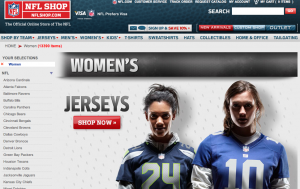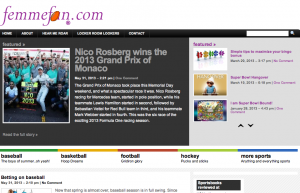“Scarborough Sports Marketing Research noted the number of female sports fans has increased tremendously over the years (“The women are sports fans,” 2002; Vogt, 2002). In fact, the percentage of women who claimed to be very, or somewhat, avid sports fans doubled between 1998 (29%) and 2002 (58%; Gaffney, 2002). In 2008, women comprised 45% of fans of the National Football League (NFL), with 35% being avid fans (McCarthy, 2008). The SportsBusiness Journal reported women made up 42% of fans of Major League Baseball (MLB), 31.8% of fans of the National Basketball Association (NBA), and 24.1% of the National Association for Stock Car Auto Racing (NASCAR) fans in 2007 (Spanberg, 2007).” (Farrell et al., 2011, p. 190)
As you can see female sports fans comprise a sizeable fraction of the sports market. Therefore, it makes sense to direct sports brands towards a situation where they recognize the growing number of female fans. Otherwise, the result equals a considerable amount of ‘lost revenues’ and that would violate pursuits of commercialization, which becomes more popular when managing sports brands. Society and the sports world in particular have been characterized by stereotypes for what reason sports have been associated with a ‘man’s world’. This condition has often meant that sports brands pay no or limited attention to relevant parts of their fan bases given the prejudice that a woman would rather cook or watch a soap opera than watch or participate in sports. Therefore, significant revenues are lost for sports properties and for brands sponsoring sports or promoting themselves through sports!
In an era where sports marketing research has played a larger role for the best sports brands in the world, these brands have started to recognize women as a powerful segment, which is a sound development. ESPN (2012) reports that the National Football League (NFL) strategically has aimed at targeting promotion towards female fans and that the league is starting to reap the benefits from these activities. For instance, NFL had an impressive enhancement in female merchandise sales, which showed an 85% increase during the 2011 playoff season in December over 2010 and a 125% increase in January compared with the previous year. Additionally, the amount of female fans engaging themselves in fantasy football doubled in 2011, which is a powerful sign of brand loyalty. NFL also did well in realizing that wives and daughters of coaches and players are great brand ambassadors of the game. According to this, Suzanne Johnson, who is the wife of New York Jets owner Woody Johnson helped push NFL fashion into ‘high fashion’. In a response to this development, Ann Bastianelli from Indiana University’s Kelley School of Business stated that “70 percent of important family decisions are made by women”. Considering that women are essential decision makers when managing the family’s distribution of disposable income, this is a ‘call for help’ for sports brands, which are not as cognitive and intentional concerning the integration and execution of these trends as NFL!
Photo: from the NFL web site.
Photo: from the ‘Glam Slam website, where fashion hits sport’.
Though, there are many sports brands out there, which do not allocate the same resources to integrate research trends and data into their marketing efforts. As a result, these latter sports brands typically find it harder to reach competitive advantages and to optimize their revenue streams. Think about how to leverage your offerings in relation to female fans by recognizing and concentrating on the concrete needs of female fans. In general, consumption patterns have illustrated that meeting specific needs in relation to gender differences are important for marketers. Consider why someone came up with the need for sports bras and marketed that intensively in the 1970s? Here is my point. For many years, marketers have acted consciously in reference to the importance of targeting female consumers and now we need a broader portion of the sports industry to follow in these footsteps. Simply, a wider recognition of female fans combined with boosted emphasis on the importance of catering to female fans may be what can take a sports brand to the next level of revenue maximization. Suddenly, a sports entity may stand stronger in terms of profit-making due to better overall positioning resulting in being more marketable for the media, investors, advertisers and sponsors.
In Denmark, rhetoric statements from the Danish Football Association (DBU) point to the importance of exploiting the growing body of young female football (soccer) players. It may have helped that DBU hired a female commercial director, i.e. Katja Moesgaard, but when concluding on this Danish example it serves a purpose to mention that these statements reflect new, innovative and positive tones from DBU. Specifically, all sports entities should aim at optimizing the exploitation of their commercial assets. Assume that successful catering to female soccer fans in Denmark may lead to women persuading their families to attend football games or to consume football offerings regularly……Then, football entities in Denmark may generate a larger brand loyal following of interest for all stakeholders in the football landscape?
For years, we have also witnessed ‘special promotions’ in the business of sports targeting male fans, e.g. ‘Father’s Day promotions’ and ‘Boy Scouts events’. It would be liberating to see that more sports entities improved their promotion of female initiatives. In a time where there is exhaustive focus on reaching kids in relation to the intersection between ‘sports and health’, consider what sports entities may win from incorporating this agenda into their marketing strategies in a way where the female side of the equation also gains attention. Famous Swedish golfer Annika Sörenstam is a perfect example of a top-notch female athlete, who prioritizes this role. She does well in meeting these needs and seem to cater well to female fans and to the intersection mentioned above, e.g. via her initiative ‘Annika Experience’.
Photo: from Annika Sörenstam’s web site, click here.
For sure, sports entities must adapt to the new paradigm underlining the equality of opportunites as it relates to gender differences. As Jori McMurtrey (2012), a female sports enthusiast, writes in her blog under the title ‘A New Breed of Woman: The Avid Female Sports Fan’, “I can join the conversation among male coworkers in the break room because I watched LeBron drop 60 points against the Magic the night before. I can build relationships with new friends, clients, and perfect strangers because I understand and appreciate the passion they have for their local teams and heroes.” From my point of view, this citation marks a critical lens on a shift in power in the business of sports. Sport entities cannot allow themselves the freedom to focus solely on male fans. That would be pure STUPIDITY. Female fans constitute a new socioeconomic authority, which sports entities must take seriously.
Photo: from femmefan.com, a fan site for female sports fans, click here.
Check out these videos:
Danish sports and fashion wear brand Hummel exploits the potential in supporting ‘Sensational Football’ at Roskilde Festival in an attempt to successfully position the brand in relation to female consumers.
Sensational Football gives female football (soccer) enthusiasts better opportunitIes to SHINE.
What to wear when you are a female sports fan. Check the video above to get inspiration.
NFL’s ‘fit for you’ campaign, see above.
New York Yankees’ fantasy camp for women, see above.
Sources:
ESPN, (2012, February 3). “NFL May Be Hitting Stride With Female Fans”. Retrieved, check link (click ESPN).
Farrell, A., Fink, J. S., & Fields, S. (2011). Womens Sport Spectatorship: An Exploration of Mens Influence. Journal of Sport Management, 25(1), 190-201.
Gaffney, J. (2002, November 21). Female sports fans are a hot market. Retrieved from www.mediapost.com
McCarthy, M. (2008, September 17). Marketers alter their pitches with more females tuning in. USA Today. Retrieved from http://www.usatoday.com
McMurtrey, J., (2012, May 30). “A New Breed of Woman: The Avid Female Sports Fan”. Retrieved from Huffington Post, check link.
Spanberg, E. (2007, July 16). “Winning over women: Teams, leagues share their strategies for reaching and retaining key demo”. Street & Smith’s Sportsbusiness Journal. Retrieved from http://www.sportsbusinessjournal.com
Vogt, H. (2002, November 15). “Meet the women who watch sports. Surprise! A third of ‘MNF’ viewers are female. Media Life Magazine”. Retrieved from http://www.medialifemagazine.com




COMMENTS
No comments yet.